![]()
![]()
![]()
Use LEFT and RIGHT arrow keys to navigate between flashcards;
Use UP and DOWN arrow keys to flip the card;
H to show hint;
A reads text to speech;
30 Cards in this Set
- Front
- Back
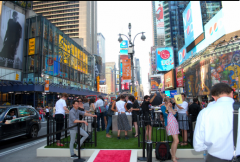
|
Paul Ramirez Jonas, Key to the city, 2010 New York City
promotional poster for the work the rhetorical triangle, and public sphere. artist object viewer. viewership, and possibilities of engagement social practice art artist born in california raised in honduras and lives in nyc demonstrates long standing interest of artist of exchange between artist and spectator in production of art in this case an exchange of key (sometimes he asks for a contribution like a wish or a penny) asks viewer to participate fully in work the key and creative possibilities of the key, a symbol or item explored by artist in the past they key meaning something private, to share it and its meanings. the idea of something locked or unlocked and the social implications of this key as a vehicle for exploring social contracts, questions of trust and conduct key to the city given as ceremonial act key given for bravery, social commitments, ceremonial civic honour meaning a welcoming gesture. the keys dont really unlock things premis for key project master key unlocks 24 cites around the burroughs of new york, public and private spaces negotiate with owners individual would get key and a passbook, simply by participating in ceremony parters must exchange ceremonial key could be a stranger or a friend key keyosk or commons in timesquare for a month, a small green space, something that would normally be used for samples for example you would wait in line and get a key for community gardens, areas around police stations a electric box, city is big enough that you would only see a few in a day resident or visitor engages in a complex portrait of a city in a new way curator nato tompson contemporary curator conected to social practice work "keys are given by mayor to hero or dignitary new key belogs to us, awarded to us by us, aknowledges people for kindness debate discussion and debate. step back and reflect on communal space opens sites, and realizes the city is a series of spaces some of which we have access to some of which we do not" lock box with a switch for a light. filled with notes, business cards, various articulations. part of the promotional ceremony material encourages you to blog or write about experiences how do practice and context come together, social practice art inquiry and participation or activity inquire around an issue and then activate or participate, do something in relation to issue social practice art broadened from connection to phsychology becomes art that is socially engaged, public art community engagement social practice art is distinct socially engaged the social interaction is the art there is no object that is art, the social interaction is the art social practice is a reaction to economies of art there is no object to sell or endorse pablo helgerra from moma developped a lot of curriculum around social practice art defined as "we spend years in art school taught to explore ourselves, individualism. social practice is about the opposite to listen and remaining engaged with world in an active way"
|
|
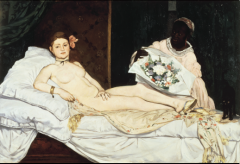
|
*** Édouard Manet, Olympia, 1863
thought to be one of the artists that started or is loosly connected to impressionism the terms or names of movements are not always what the artests called themselves, he did not use this term modernism changing cultural production reclining female nude in relation to subject matter or technique take up the move towards modernization how modernism is important with subject and technique very confrontational in its day, he only showed it to a few close friends for two years finally showed it in the salon 70 reviews were bad only 2 were not caused a huge uproar critiques hated the work took as subject painting by titian manet modeled olympia off painting venus, in titian, pushed towards picture plane at the feet is a dog, the dog means fidelity in the back of the image are two servents one is kneeling geting clothes out of a marriage chest connecting venus to notions of marriage, she is the godess of marriage manet's painting shows obvious connection but she is not looking out coquettish she is looking directly at us the hand is firmly placed, there is a cat with an arched back instead of dog not a lot of articulation in background but a maid presenting flowers from an admirer loosly same subject matter but manet's is much more direct, can not be coded as a venus is instead a prostitute of the day coded in the day as a prostitute takes name from a play where olympia is a prostitute that is a social climber prostitution at the time in paris was huge, concern for bourgois because of the spread of venerial desease and the affect on the upper class families. manet himself died of siffilus manet is responding to urbanization and modernization not showing busy urban environments or trains, manet is more subtle, playing with traditional subject matter but connecting it to present social issues of the day artists less concerned with something historically codded from the past but instead focusing on isssues they are situated in as more and more people come to urban sites more tensions arise. manet is simply engaging that. impressionsit paintings are very popular today considered very confrontational
probably one of the most influential images in modern art, very copied. caused the most controvesy and caused a big break between academic painting and new kinds of painting. unblended colour is starting to be played with called themselves the indipendets although manet was part of the academy most were not the independents held 8 independent exhibitions seperate from academy salon exhibitions used the exhibitions to test general publics reaction |
|
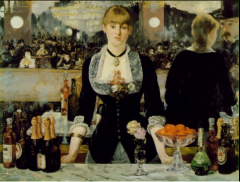
|
Édouard Manet, A Bar at the Folies Bergere, 1881-2 speaks to issues around modernity also everyday modern social spaces, a night club/ cabaret folies begere a spectical driven night club shows bar maid ready to serve custumer behind her is a mirror reflecting the night club two tiered situation, two tiers of entertainment and multiple bars people holding up looking glasses there is a bottom of a trapese artist in the top left corner the notion of the reflection is odd the barmaid and her reflection and paitron in the reflection. we are in the place of the patron the reflection is squed on purpose, he is painting an effect. the bar in the forground and the reflection in the mirrior are not perfectly reflected if we were the reflected patron what would we stand on the bar looks like it is floating, there is nothing it is sitting on. he can paint fine, he chooses to abstract the image manet is conveying not what what the bar looks like, he is trying to convey what it feels like, disorienting, overwhelming, destaybalizing everything is happening at once manet is playing with public sphere alowing space in composition for subjective interpretation, which is new at the time artist deviated to paint what he wanted, he painted an experience prioritize individual expression, connects to modernism
|
|
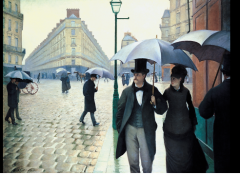
|
Gustave Caillebotte, Paris Street, Rainy Day, 1877 artists painting outdoors because the calapsable metal paint tube was invented in 1841, so in the 1870s it was popluar and people were able to paint anywere painting en plein air
flåneur different impressionist artist, was indipendantly wealthy, so didn't care if his painting sold or not, collected art and supported indipendant(impressionist ) artists, was a main contributer to the 8 indipendent exhibits shows the flaneur/ stroller, being seen in public sphere moving in it, becomes important, there was a new city to do this in paris from 1850-1870 goes through a dramatic urbanization/ gentrification/ modernization creates a destabalization in a way historical phenominan when napoleon the 3rd put a superintendant barron george haussman in charge of rebuilding paris as a modern spectacle massive publics work started to improve lighting sewage systems, traffic, by making big boulevards rather than narrow medival winding roads to make residential and commercial structures the buildings were standardized, the cornice heights had to all lign up with eachother, retail on the floor level and apartments above remenants of the modernization are everywhere in paris today 85 miles of straight wide tree lined avenues created boulevards created to make visual vistas parks and buildings at the ends of streets about 100 thousands trees planted more bridges built and renovated houses demolished and rebuilt the new appearance of city was to reflect upper middle class notions of urban life the changing city also brought up new places of leisure, parks, cafes, railstations, all new subject matter for artists so as artists pass through in the flaneur there was much change to observe, and their roll of an artist to represent modernism, what is their identity when representing this change when caillbot died he bequeathed his art to the state, who didnt want it he did it as a confrontational gesture, he knew that they still didnt like it, so he bequeathed 65 of the best to them, they only took about half, they sold the other half which is why chicago and new york have such a big collection outside of france of this art
|
|
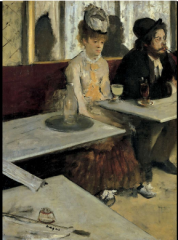
|
Edgar Degas, The Absinthe Drinker , 1876 social costs of the modernization of paris the hausman plan and the radical modernization of the city during the process of destroying and rebuilding the city 350 thousand ppl displaced 1/3 of the people were displaced 1/3 move out and a million moved in renovate and modernize the buildings, increase the rent, the people of lower classes are moved out and people of higher class are moved in this is a shop girl, she is dressed to show she works in the city, but she couldnt live in the city people were living in the outskirts of the city and would commute in the lowest socioeconomic parts of the city had to to commute in the social cost to the city are organized around class strata people of the day praising the modernized city, but there were poeple criticizing it saying it just covers the real issues behind the city he was concerned not with the spectical but the unerbelly he painted the shop girl, disenfranchized, sitting next to a patron of the bar, working class dress, not low or high class situates us as if we are part of the scene, forced perspectival view we are in the forground connects viewer to it the name and the glass say she is drinking absenth the drink disapeared off the market in the 19 hundreds is back now after having been re made it was pulled because it caused phsycosis was a hallucinegen what about her social conditions put her in this condition, he isnt moralizing it, but is showing that this is part of the urban environment too. clean up efforts in vancouver every few years to move people out of the downtown east side, what does it mean to move people out from where they are this is part of his flaneur and what he sees the disenfranchized and displaced were of interest
|
|
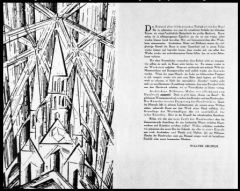
|
Walter Gropius, Bauhaus Manifesto, with frontispiece by Lyonel Feininger, 1919 woodcut frontispiece looks like a cathedral connection from medieval craft and bauhouse gasamtkunstwork, and medieval art and the bauhouse all come together bauhouse, true art and design, should be gesamtkunstwork a complete work of art visual culture should conform the bauhouse key word house of construction two schools came together a craft school and an art school the bauhouse had a big effect on pedagogy bauhouse closed because the thirt reicht found it very offensive to their traditional taste teachers architects and architects moved out of germany, walter gropius moves to chicago to start a new bauhous school, many moved out and started new art schools manifesto, demonstrates articulations around te bauhouse architecture art and design all came together most teachers were architects, break down of separation of the arts, all art brought together a complete work a total work of art, no devision of the arts woodblock print has cubist impressionistic print of cathedral talked about gropious in text, the goal of everyting is building or making articulaton of the past and proclemation of the past, we must all get back to craft. with out class devision and arrogant barrier of crafts and artists architecture scuplture and painting, inclusivity
making is
|
|
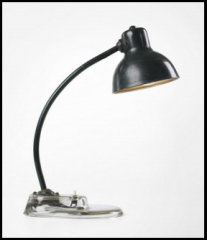
|
Marianna Brandt, Desk Lamp, 1924 women had an easier time at the bauhous then the academy, women accepted as much as men gropious and some teachers would push women into certain departments, like weaving and textiles. there were still gender politics at the bauhouse but not the same as in the academy system form composition colour, workshop training practical instruction, classes would be attendended regularly in the work shop devisions among the faculty. how technitians and the faculty often clash or have a heirachy or devision brandt was a student graduated in 1928 became head of the metal work shop produced house hold objects, one of the most successful graduates for having negotiated contracts for production the notion of making objects affordable to the masses is funny because this stuff is worth hundreds of thousands of dollars now this lamp had an ashtray with the lamp brought together at the base she would produce functional designed objects, but also objects for conceptual artistic motives the vymar republic, before hitler came to power was a time of growth for femenist ideals part of society considering complex situation of women at the time
|
|

|
Walter Gropius, Bauhaus, Dessau, Germany, 1925-6 architecture, the rebuilding of the second manifestation in dessau gropius designed new campus, thinking of dessau as a way to play with industry was an up and coming industrial town the government was becoming more conservative where they were so he thought it was a good idea to move in 1925 the preliminary course was lengthened to a year the workshop was overhauled ceramics were eliminated workshops were run by teachers, before but now there was a intermediary, a person who bridged that the bauhouse font and universal style the structure is reinforced concrete and large areas of glass the glass is about the functionality of letting in a lot of light to studio spaces and workshops to demonstrate the functionality of the space it is now a conference/study centre that can be visited there were 3 wings to hold everything, demonstrated very functinonal architecture architecture was set up, gropius left, and systemic teaching of architecture was implimented form follows function. was important, but quality and care were also important in the end with the third director bauhouse font, universal type by herbert bayer
|
|
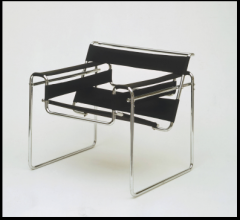
|
Marcel Breuer, Wassily Chair, 1927-8 international style key word named after kendinsky minimalist chair, paired down to basic geometric form, clean lines no excessive ornamentation truth in advertising, the steel tube of the structure and the leather strips demonstrate what they really are. the chair is only made possible by experimenting with a new material. the tube of metal came out after the war, was used for handlebars of bikes it is geometric simple truthful in materials international style also connects to art and design not only architecture form follows function, bauhouse sleek modern connects to materials: ideologies the ideas of value are constructed
|
|

|
Kerry Tribe, H.M., 2009 time based work la based film viedo and instilation artist explores time and proesses cognition image and text, how we process information and make sense of it work in general is with a time based media often connects to an instilation we are not seeing it as it would be in a gallery image of witney space, walk through space with 16mm projectors would hear the sound of clicking as entering the space split screen projectors, here there are two projectors there is a looping of film it is shown through projector on one side, 20 second delay then starts on the other side so starts then 20 seconds later starts on the other side of the screen quasi documentary practice this is a true story patient known as HM, amnesiac has a 20 second recall of memories as a child suffered epileptic episodes, at 27 had a surgery to fix epilepsy. after age of 27 couldnt remember anything after. 20 second recall hm was never filmed is an actor he was studied a lot, because of studying him we know a lot about how memories are formed, and where in the brain memories happen fundemental to knowledge we have in 1953 until his death in 2009 he was studied on a yearly basis. dialogue is all real dialoge from transcriptions female voice is a doctor a true story everything else is a construction based on historical facts the footage and animation are based on what he may be experiencing see something on the left you dont always remember you have already seen it cognitive dissonance, is the cause of this, the distraction and casues a confustion she plays with the cognitive dissonance with the delayed split screens and with the sound time based media but also gets viewers to experience time and short term memory hm born in 1926 1953 is when the operation was frankly experimental operation, cuting out part of the temperal lobe playing with time and memory
|
|

|
Pablo Picasso, Les Demoiselles d’Avignon, 1907 avant guard moment where cubism is defined this is the beginning of cubism movement, but beginning is 1908-1914 in 1914 the war starts and stops experimentation in art a critique applied term to art in 1908 after hearing matisse talk about this painting "as if its made of nothing but little cubes" a formal composition based on a geometric shape or underlying structure first art movement that breaks with illusionism impressionists show a feeling or expression of scene, but still shows scene, where as picasso here is less concerned that you understand the image but focuses more on the underlying structure of the women named after a street in barcelona, known for brothels women represented in an unclear way, where is the model where are the surroundings? he wasnt concerned with copying an image, more interested in complicating the image when he painted this work it wasnt shown for 9 years after it was made this infamous painting it a nerve, 5 prostitutes orginized in striking seductive poses, conisider notions of the gaze a radical departure from form, splinters of colour rather then rounded volumes and space there is a flattening of the image and takes us away from the ilusion of women and realness of the women is a large painting monumental scale 3 figures apear to have masks, there is an agressive quality. the work played with psychological concerns of the day apropriation occurs, picasso is looking at masks from colonialist efforts and changes the faces to represent masks. he was interested in ethnographic museums because it allowed him to add difference and deviate from strictly european styles. He is apropriating art work to signal his avant guarde differences what prosititution was doing at the time, the spread of disease and siffilus is an issue with the bourgeois, regulations were made such as maditory health checks and licenses. there was a fear around prositution at the time in paris picasso would paint then sketch then paint then sketch, and use sketching in the process of production reception was very rough "what a loss for french art"
|
|

|
Georges Braque, La Portuguese, 1911 this is a portrait of someone portuguese continues 3 quearter view head at the top and torso in the middle is about careful looking text on the tip dbal. they were intersted in the mass media, could be a text off a poster of the day for a cafe dancehall elements to the right that are painted more illusionistically, rope and ancor almost at the base is what appears to be a sound hole for a musical instrument the signs indicate a guitar or a stringed instrument the texture added to the canvas show artists working out techniques and stratagies the image is defined with its title so the viewer knows what it is braque said that it is based on a memorie he has from his youth of watching a portuguese man playing an instrument we are given the signs to make sense of the image. the cubic interest in philisophical issues of the day are being explored the interests in time are manifested through the modernization |
|
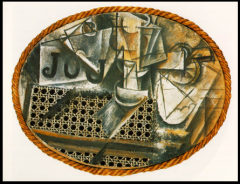
|
Pablo Picasso, Still Life with Chair Caning, 1912 a painting conveying more then a frozen moment in time this is an oval canvas bound with rope that is meant to look almost like a baroque guilded frame this is synthetic cubism the last stage of cubism encorperates multiple types of materials the rope binds the canvas and the faux chair caining paper pasted to the canvase a type of collage and some painted signs that are textual and painterly this is a still life with chair caning as the title sais "JOU" the root of the frech word jouer or journal to play or newspaper the tongue and cheek ness an invitation to play from the artist to the audience there is a playfulness to the composition looks like a table with things on top of it objects could look like a cup, or a pencil/ cigarete a newspaper or a book this image and use of varied elements, are giving the audience the experience of being in a cafe, sitting at a table, reading the paper having a coffee smoking a cigarette all the signs and how we can interpret them together
|
|
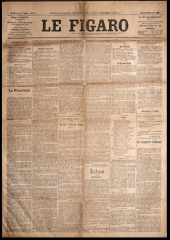
|
Filippo Marinetti, Futurist Manifesto, published in Le Figaro, 20 February 1909 published in on the front page of a parisian newspaper to announce movement publicly that milan will be the center and not paris or france public decleration of intention and what this means to social change the tone was almost confrontational and pushing for change
|
|
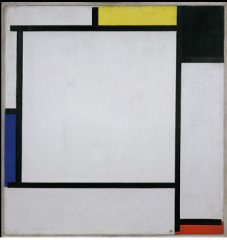
|
Piet Mondrian, Tableau 2, 1922 the impotance is on you to decide what it is it takes more work to understand it the artists found it more egalitarian but most people dont like it because they dont understand it people would rather look at a rembrant that is familiar and they understand mondrian was very influenced by the work of broque and picasso in 1911 and also vangogh a colleague thought the right angle was a completely man made invention and therefor found it to be a better articulation of human endevor. it was a reductive image with reductive angles and reductice colours he found himself a philosophoer, wrote about his self named genre neoplasticism - how something is formed. and what he was doing and its meaning theorizing it quite heavily. ballance, purity, equilibreum, harmony, and repose are what he said he was making small orginizational elements, primary colours and horizontal and virtical movement trying to create a utopic society connected to the issues around WW1 and striving towards a better world believed that the art was really important in leading a change to utopic society
theosophy utopia key words
level of thoughtfulness that isnt immediately apparent, but is hugely there would take a year to complete the work of art a space to contemplate your own existance and understanding of what is happening with modernizatino for example the image offers a contemplative space an interesting response to what was happening at the time
|
|
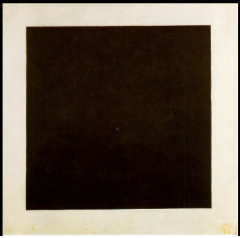
|
Kasimir Malevich, Black Square, 1914-5 utopic response to modernism, utopia geometric abstraction thosophy envisions himself as a priest like figure talking about work as if it has a spiritual significance conecting work to icons art for arts sake artist from russia but about to become soviet union after revolution who is the first artist to practice complete abstraction supremetism is his type of abstraction 1914 and 15 published in an article for an exhibition in st petersburg, sais that we need to get away from representational content ("shameless neudes") the black square is "the first fist step in pure creation in art" this painting is "the zero of form" according to malevich most reductive elementary art the building block for which all composition and organization should be based a starting place what is the image about the notion of the right angle was important for malevich always very geometric the right angle demonstrates the work was made by a human hand thinking the shape does not occur in nature the angles shows a completely human made mark the black square is a void for a projection surface art for art sake is about self reflexivity and introspection a space for you to project your own thoughts desires critiques imaginations the artist is giving the viewer agency in how they want to use the work, providing a venue for critical thinking provide you with a space to contemplate with know tangible outcomes the viewer feels anxious watching this, there is a lot asked of the viewer how can the viewer look at this and engage with the art piece, a place in life where you can just think with out tension or direction of social and political pressures supreme feling and emotion. supremesism supposed to be a conduit to feeling the black square becomes so important to him that by 1919 he signs artwork with it, he also has it put on his tombstomb it becomes part of his identity in the corner is the space where icons would go, malevich installs the black square in the corner so that it becomes a space where you can project your own ideals
|
|
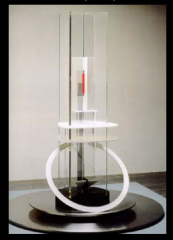
|
Naum Gabo, Column, 1923 a constructivist addetive methode of structure a column represented in a different way then traditionally done two materials: volume and mass the play between volume and mass, and space and time create new visions the roundness of the column is not created by virticle plexy glass elements, its the hanging circle and base that demonstrate the roundness and its distinction as a column the pexiglass was a new material at the time what simple ways can he express volume mass time and space simplistic geometric forms conected to egalitarian art access for everyone, transarency of materials
|
|
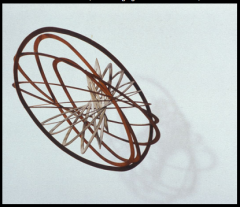
|
Aleksandr Rodchenko, Oval Hanging Construction No. 12, c.1920 constructevism artist a hanging work with no sculptural base playing with notion of volume mass time and space and playing with relationships to form eucledian geometry explored by creating sculptures that interpret that form an oval shape cut out of plywood, then keeps cuting out ovals from flat plane, and then offset and attached with wires some parts painted meant to convey the real form of an oval, the dynamesism of the shape the notion of a hanging sculpture, that moves pure form and antidote to false consiousness there was a question to what art can do in political climate should art be free of didactic intentions
|
|
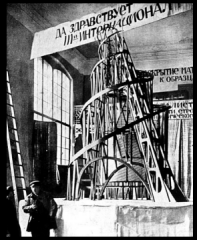
|
Vladimir Tatlin, Model for the Monument to the Third International, 1920 constructivist notions of representation for soviet society the artists believed that the utopic aspirations they had could help create a better society tatlin was the most enthusastic supporter of socialist society wanted to connect ideas of government with constructivist art its a model for an architectual structure that never gets built and could never be built was planned and thought out because it was a popular idea even though it could never be built the art work toured the city would be in parades and in socialist demonstrations a scale model of what is meant to be a very large structure meant to commemerate the third international soviet congress 1919 is the third year after the revolution the soviet govt comissions him to build something to ecompass utopian possibilities cylinder shape and cube and pyramid, geometric structures were to be different structures to hold public, each would rotate at different speeds the cylindrical structure would hold meetings, would turn once every year the cube would be a govt meeting hall to assemble congress the small pyramid at the top would be an information communication structure, to use satelites and recieve info to desseminate information down and project information onto clouds on a couldy day. hyperboly, couldnt be built at the time was a very forward thinking structure a momument to govt and an access of information from the govt to everyday people an egaletarian notion of the socialist utopic soviet society the ideal was that this would be a model of how govt would function and everyone would be involved in what was happening and informed he saw his role as a maker, and that he constructs a solution to social needs and aspirations as a constructivist merges present notions of artist and designer the monument tours.
|
|
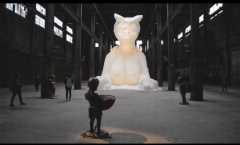
|
Kara Walker, A Subtlety or the Marvelous Sugar Baby, The Domino Sugar Refinery, Brooklyn, NY, 2014
temporary instilation at a site that is being gentrefied and turned into condos long elaborate title interested in victorian language work normaly deals with race relations, and sexual identities though the use of theatrical, or panoramic images creates often very provocative images artist grew up in california then moved to georga where her skin colour became something that was coded when it handent before america is very devided still to this day is a 5 story tall site about as long as a football field plant originaly built in 1957, it held sugar that was about to be refined brown sugar refined to white sugar, metaphore can see molases oozing of the wall and the work is made of molases and sugar is half sphynx and half "mami" steriotype-a nany to the masters children within a slave household would separate her from the other slaves and allow special privliges the figure is used in many ways, even in aunt jemima maple syrup figure is coated in sugar and sugar is on the bottom the work is meant to create a sense of discomfort people in the us could not come to it with out an understanding of the notion of slavery, mostly occured in the south due to agricultural production there are also small boy slave resin scupltures covered in molases the history of sugar in the us, is a story of slavery connecting to the triangle trade, to ensure sufficient slaves, slaves were taken from africa to the us, then sugar tabacco and cotton were taken from the us and sent to europe, where textiles rum and manufactured goods were sent back to africa a conection of human labour as a comodity and its conection of the exchange of goods in europe there were sugar sculptures made to be consumed at a party, a figure would be made and then over the course of an event it would be consumed it was a real luxury in the 19th century not something everyone could have the site was started in 1856 and by 1870 it was producing 1/2 of the sugar in the us-1200 tones of sugar a day the smell is in the air and hangs all around the factory the back of the sphynx is overly sexualized it was not uncommon to sexualise the other in steryotypical representatives of scale the vagina was 10 feet tall sponsored by creative times, and nato thompson people interacted with the art by taking selfies with it, putting themselves in the art work in ways that continue to exploit and over sexualize the images
|
|
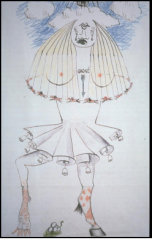
|
Andre Breton, Man Ray, Max Morise, Yves Tanguy, Exquisite Corpse, 1928 automatism automatic drawing where your hand can move freely along the paper freed of any rational control connects to what surrealests were doing, exquisite corpse- 4 surrealist artists played this game all the drawings are titled exquisit corpse paper devided into 4 head, upper torso, lower torso, legs, no one would see the other person's drawing only connecting marks by not being able to see the whole image you would have less control, and then would allow the viewer to see the image illogically mismatched head then body and waist bells on skirt and animal legs and eggs it was how can the image call up for the viewer new assosiations, and help break down structure normally applied to looking at work
|
|
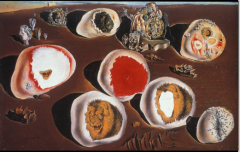
|
Salvador Dalí, Accommodations of Desire, 1938 not so interested in automoatism free assosiation was practiced as a strategy show a work to someone and use the response calls up dream imagry used dream interpretation practiced phsychoanalytic analysis with a therapist and recored dreams, all fodder for paintings spanish artist spent a lot of time in paris exemplified surrealist painting to the public, taken up and known as his persona as much as his painting louis bunuel and him made a film un chien andalou first surrealist film dali developed many thoretical methods of approaching art paranoic critical method where he used symbols connected to paranoia sexual phsychopathy was studied where he came up with his paranoid critical method there are somethings that come up with many of dali's artwork such as a high horizon line images that can be read in multiple ways, first look you see one thing then second look notice more the feeling of insects creepy crawly feeling, are what he is experimenting on the left hand side there is a profile of a face, a self portrait, persocution mania, he represented himself over and over again, it was hard to see what was true and what was an act to increase popularity, either way he was represented over and over again two men at the top with insides open to the viewer surrealists are making it recognizable, but are in a way trying to trick you or call up some troubling feelings Repression
|
|

|
Claude Cahun, What do you want from me?, 1928 cahun's life was a kind of performance androgeny, and a documentation of reality and what sexual identity and what that means two heads, a double headed figure body morfed together two that are confronting or struggling with eachother one looks out to the world the other is turned in with only one eye showing the face is turned in almost an agressive face the normal figure on the right may be haunted by the one on the left, the dual notions of identity and sexuality
|
|
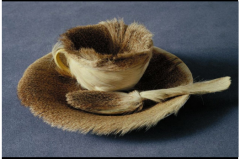
|
Meret Oppenheim, Object: Fur Breakfast, 1936 there was an exhibition of surrealist objects in paris, it was the first showing of this type of work that moved this out written or painted or photographed work, it were things that could be interacted with. she is known for her sculptural production she plays with notions of femininity the idea of tea and making and serving tea, then covered in fur, women are covered in fur as something to be taken care of the tea cup is a smooth porcelin thing, being covered in fur makes it more femenin and sexual and indicative of pubic hair came out of a conversation she had with picasso maybe, he said she could cover anything in fur even this cup how would it feel to use this cup, how would it feel emotionally to be drinking of a fur cup fememninity as a server of tea but also an object to be wrapped in fur
|
|
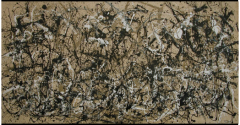
|
Jackson Pollock, Autumn Rhythm, 1950 very interested in the unconcious ideas of dream interpretation drip paintings came out of that period his process was putting unstretched canvas on the floor, and would fling house paint on the canvas ink would bleed, and the more he would layer paint the more it would scane and layer he would cut the canvas after, and would have clement greenburg help him name his art. clement greenburg most famous 20th century art critic formalist modernism critique techniques studio floor dirt would get into the paint, cigarette butts and paint lids greenburg would talk about the formal elements but not about the social political issues around paint pollack has issues of mental health and alcoholism, dies in a car crash driving drunk social context was meeningful to artist, but the critics devorced the art from the meanings around it interesting with the rhetorical triangle some said he was the greates artist of the day action painting, the form of physical engagement can be cathartic adn a working through of the difficult social context the physical interaction with canvas allows some tensions to be worked through rhetoric around work that it could reshape and connect the public with contemporary art |
|
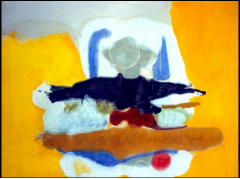
|
Helen Frankenthaler, Yellow Clearing, 1962 female artist had a very different set of options open to her had an affair with greenburg for 12 years, he never wrote about her or presented her work the artist as a hero as a definition and its affect on female artists, can this artist be a female fits the conceptions of modern art, frankenthaler's technique was unstained canvas, would dump very thin layers of paint on the canvas frankenthaler did show through out the 50,60s and in the 70s was taken up as someone important to be seen he she is represented compared to me in "soft, landscape themed, bleeding, femenin, unassuming" there was a gendering around the reception and around notions of the artist |
|

|
Aerial view of Levittown, Life magazine, New York, June 1948 factors contributing to highmodernism after ww2 we have the birth of advertising culture and greater consumerism, there is more magazine periodicles, and also television ww2 male citizens go to war, then women shift the work force to fill in jobs, then there is another shift when the men come back the american dream implying that only in america can you move through class status. from hard work you can rise up and participate in capitalism much more after ww2 the us emerges economically and technologically on top the technologies are used to produce consumer goods and drive the us economy many possibilities that come up and rhetoric of the american dream pops up you would have a home and a suburb one of 4 sub devisions produced by levit and sons around new england, on the east coast new york, all collectivly called levit town this was something you could aspire to this was some of the first housing all produced through kits a delivery to a site of everything you need to build a house so people could build a chouse very easily and cheaply and quickly even with a picket fence with the invention of the suberb, there are broader highway systems and reliance on cars and oil these homes were affordable, you could get a grant and pay your home off with the average salary how can an individual participate or not in a market ussr and usa and the tensions between the ideas of societies private ownership versus collective ownership along with the production of suburbs and premade homes first three hours after the publication of the homes were made 14 hundred homes were sold there was a real demand after homes were sold, the need to fill them was there dishwashers, and toasters, marketed to women, the construction of identity rollingstones mother's littel helper, suburban house wife pops pills because its so boring and terrible. marginalized women who can be excited at a new dishwasher |
|
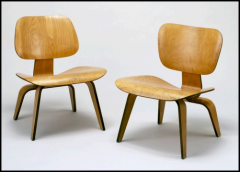
|
Charles and Ray Eames, Lounge Chair Wood (LCW), 1945-6 the chair is made in connection to the body charls eams and his friend experimented with moulded plywood they entered a competition that if they won they would provide funding for distribution and manufacturing products new technology of moulded plywood was complicated was used to help with war effort, he made moulded splints to help with support of injured troops seranin wasnt involved in the project of the chair, and chales and ray made it it is still being made and one can still purchase original chairs mid century modern key word designed using technology for moulding plywood from ww2 relationships between the body the bodies used to test this were mostly male bodies the ways we look back at mid century objects as valuble compared to how we look at present day objects-planned obsolescence |
|
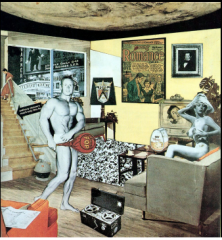
|
Richard Hamilton, Just What Is It That Makes Today’s Homes So Different, So Appealing?, 1956 a collage piece quite small produced to be photographed to publicise and be a poster a white chapel gallery art show first time a group of artists are connected to the term pop art an international movement not just andywarhol japan england italy and the us the legacy of corperate capitalism implicate art production key word pop art work that takes as its subject matter contemporary subject matter pablo picasso did this with journals and magazines and posters connections to pop culture and comodity culture has happened before this but in this case it is fundamental to the ideals this collage produced at the same time of mark rothkos paintings shows competing ideas of what the everyday world and socity means is pop art critical or celebratory of mass culture shows a couple in modern dwelling semi neude figures tarted up in silly ways body builder with tootsy pop at fallice level there is an audio recorder, but also a jacson pollack painting as a rug a television a canned ham corperate advertising the female figure uses a vacume with a sign playful but also connects notions of pop culture and mass media the constructions of identity. the fasination with popular culture and mass media, celebrating and critisizing it |
|
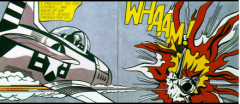
|
Roy Lichtenstein, Whaam!, 1963 influenced in the procedures/ techniques of mass media, but also the subject took often comic strips interested in perception, how do we understand images interested in hoit T sherman who was working at how we see representation came to idea of representation and painting that connects to the manufacturing of mass media products process of screen printing for newspapers, the half tone method of printing a news paper image where its mostly dots, dots fascinated lichtenstein the ben-day process makes the tiny little dots if you look at an area of colour you can see the dots looks like a simple solid colour but actually provides a tonal range to create ideas of depth and distinction to convey the message necessary he paints with dots in almost all works early days was done by hand, but then moved to a stencil then pre generated dots that he applies to subject comics advertisements and stories that work out social relationships this is a diptic, two pannel painting 14ft long large scale owrk taking the image directly from a ww2 comick he shifted the image slightly to heighten the drama a us fighter plane, and then the enemy plane engulfed in flames playing with subject matter that in the 50s and 60s that connected to a rhetoric of ww2 american might, was he reifying it, or being satyrical wasn't just about entertainment, social claims of steriotypes and identity, a cultural production about understanding ourselves at the moment in the 50s comics were not signed as much as they were today there were a few moments where he borrowd from images, and the artist was attributed, but often it was just the publication ideas of might and right, cold war context |

